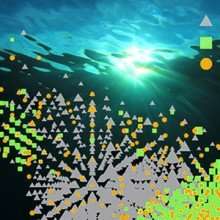Study helps explain how sunlight alters microbial pathways and stimulates respiration in waters in the Arctic. Credit: Environmental Molecular Sciences Laboratory
Sunlight and microbes interact to degrade dissolved organic carbon (DOC) in surface waters, but scientists cannot currently predict the rate and extent of this degradation in either dark or light conditions. A recent study helps explain how sunlight alters organic matter composition.
The rates microbes can process DOC is likely governed by a combination of the abundance and instability of DOC exported from land to water and produced by photochemical processes, and the capacity and timescale that microbial communities have to adapt to metabolize DOC that has been exposed to sunlight. This new information could help develop more accurate methods for assessing past climate.
Photochemical processing of DOC likely supplies about one-third of the CO2 released from surface waters in the Arctic, by either directly mineralizing DOC to CO2 or indirectly altering DOC chemical composition and, in turn, rates of microbial respiration. At present, scientists cannot predict the rate and extent of this degradation in either dark or light conditions. A team of researchers from University of Michigan, Woods Hole Oceanographic Institution, Oregon State University, and EMSL, the Environmental Molecular Science Laboratory, a DOE Office of Science user facility, combined advanced characterization techniques to characterize microbial and DOC composition.
The researchers characterized outputs of short-term photochemical experiments using Fourier-Transform Ion Cyclotron Resonance mass spectrometry at EMSL along with measures of microbial activity, community composition, and gene expression. In dark conditions, they found microbes native to deep permafrost, or surface organic layer soils, degraded the DOC that was most abundant in either soil.
They found sunlight exposure either produced or removed the abundant DOC used by microbes, which induced changes to key metabolic steps taken by the native microbial communities to adapt to and degrade the light-altered DOC. Alteration of permafrost DOC by sunlight to compounds used by microbes results in a two-fold increase in respiration rates, suggesting that when permafrost DOC is exported to sunlit surface waters it can be rapidly respired to CO2. The coupled photochemical and biological degradation of permafrost DOC may be an increasingly important component of the Arctic carbon budget as temperatures increase. The new findings could be used to develop more accurate methods for assessing climate processes.
More information: Collin P. Ward et al. Photochemical alteration of organic carbon draining permafrost soils shifts microbial metabolic pathways and stimulates respiration, Nature Communications (2017). DOI: 10.1038/s41467-017-00759-2
Journal information: Nature Communications
Provided by Environmental Molecular Sciences Laboratory
























